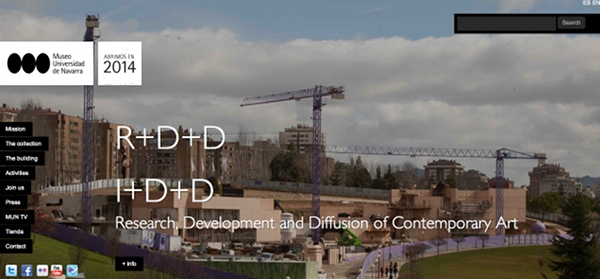Miguel has to sell a vision. Miguel has to sell a vision of contemporary art. Miguel has to sell a museum under construction – the future University of Navarra Museum. As the Director of the museum Miguel López-Remiro faces a great challenge: how to sell an art vision?
I met Miguel during his Executive MBA program with IESE Business School in Barcelona. It was an intensive week of persuasive communication. Like every year I supported my friend Prof. Conor Neill. Miguel was in one of my groups. We stayed in contact.
Let’s see how Miguel uses his persuasive communication skills to sell his art vision.
.
Miguel, a university museum, what an ambitious project… Tell us more about it!
This ambitious project began when an important collector, María Josefa Huarte, decided to donate her impressive art collection in 2008. At that moment, the University of Navarra was designing a Humanities Research Center and the idea of building a museum within the campus was born – a great opportunity to make an impact in the visual arts field.
We will be pioneers in founding a university art museum in Spain. The museum will provide new perspectives of understanding art. Based on a cross-disciplinary dialog we explore new approaches towards art from disciplines such as management, science or architecture. As a research museum we’ll be an experimental center of art for artists. All this will take place in a superb building designed by Rafael Moneo, the only Pritzker Prize winner in Spain, an architect from Navarra and a true humanist. The main campus of the University of Navarra is placed in Pamplona, and for me bridging with the city is a strategic objective. Nowadays museums are conceived as “plazas” not as “cultural cathedrals”. We want a living museum, a living vision of the unity of art.
Who are your main stake-holders? Who are your target audiences?
The main stakeholders are the founding members of the Museum – collectors, art critics, artists, professors, alumni, students, and the city of Pamplona. During 2012 I toured 16 cities in Spain, presenting the project to more than 2,500 people. We also presented the project during the last alumni summit of IESE Business School (which belongs to the University of Navarra) in Sao Paulo.
The target audience for my presentations is very large. Art is a field, which can connect all of us. Art touches all of us because art is communication. Art narrates the human experience thanks to the artist, someone who is able to transmit a message to the world through a symbol that interacts with the spectator. Those who come to a presentation or those who I visit to present the project, I encourage everyone to support our project because I truly believe that we’re facing a new way of understanding art.
Aristotle said that we need to build three pillars of rhetoric in our discourse in order to persuade people and move them to action. What is your logos, what is your ethos, what is your pathos?
I do remember that from yours and Conor’s lectures at IESE. Every time I confront an audience, I elaborate an argument that they will remember. In London I used data about the project, about the building, and I showed our collection. I explained why we are innovative and how we developed our strategy. I explained our mission of enriching the vision and understanding of art through research and through cross-disciplinary dialog in the environment of a campus.
In that presentation in London I also mentioned the reasons for me to join this project. When I received the call to become its director I was still working as Associate Director at the Guggenheim Museum in Bilbao. I’m alumnus of the University of Navarra and I was able to earn a doctorate degree thanks to the support of the same collector who donated her collection to the University of Navarra. I feel proud of the University and I proved this special connection with the collection by highlighting the artist of the collection who I’d been doing research on: Rothko.
I showed my passion for the project more like an entrepreneur of a start-up company than an intellect.
Great, as you’ve already mentioned, in London in March 2013 you had the opportunity to promote your project in front of 200 experts in the field of art and art promotion. How did you make your talk relevant to your audience and what was your first sentence?
My first sentence was: “Let me confess to you a passion that I have… Rothko.” As an artist Rothko is very important for London. I made my talk relevant to my audience by building a bridge between London and our project based on the fact that Rothko is the main artist of our collection.
What specific public speaking techniques did you use?
Drama, pathos, metaphor, message, sense of humor, smiling face, no notes at all, looking at the ones who are close friends from London, talking in a calm voice. Breathing, pauses, suspense. I also played a couple of videos at the very beginning of my speech, not in the middle of it – following your Twitter advice. I’m very happy about the outcome.
Did you also apply story-telling techniques?
Yes, I followed one storyline and ended with the same metaphor, coming back to Rothko and the importance of this artist for London and for our collection: Rothko said in 1969 in front of the faculty at Yale: I do know that many who are driven to this life are searching for those pockets of silence where to root and grow. I ended with the idea that I believe that the University of Navarra Museum will be those pockets of silence where to root and grow. I also used dialog in my speech.
In the video we can see that you end your speech saying, Thank you! How did THAT happen?
I knew you were going to ask that question, and I remember it from your classes. It’s hard not to say thank you at the end. I tried to be quick with my ending and the words thank you just popped out. Are there scenarios when it is necessary to say thank you? What other options do you propose?
For me, this is the power of the “drainpipe”. By going back to the beginning the way you did and adding an invitation like “…And you can also dig deep into these pockets of silence when you come to our inauguration in [month] 2014.” If you stop talking then and smile, your audience knows this is the end. Thank the audience after the opening of your speech, not at the very end. This is a moment far to precious to be lost in a sea of standard. But let me ask you my final question. How has your attitude towards public speaking changed since our persuasive communication week in Barcelona?
A lot. I focus on persuasion rather than plain information – using logos, ethos, pathos. I always include a message and a call to action and I use rhetorical devices such as metaphor or metonomy. Not like before, now I enjoy the moment!
Fantastic, thank you so much for the interview. I’m looking forward to the opening of your museum!
About Miguel López-Remiro
Phd in Aesthethics and Theory of Art, graduated in Economics from the University of Navarra and EMBA graduated from the IESE Business School. He has been a doctoral fellow of the Felix Huarte Chair of Aesthetics and Contemproary Art, a Visiting Scholar in the Department of Visual Arts at University of California (San Diego) and as Researcher Fellow at the Getty Research Institute.
Miguel is the editor of the Anthology of Mark Rothko’s texts with Yale Universitiy Press and Flamarion. From 2006 until his entry as Director of the University of Navarra Museum, Miguel was Deputy Director of Curatorial and Research of the Guggenheim Museum in Bilbao.
Virtual tour through the future University of Navarra Museum:


Conor
Great case study! Might have to adapt for our courses 😉